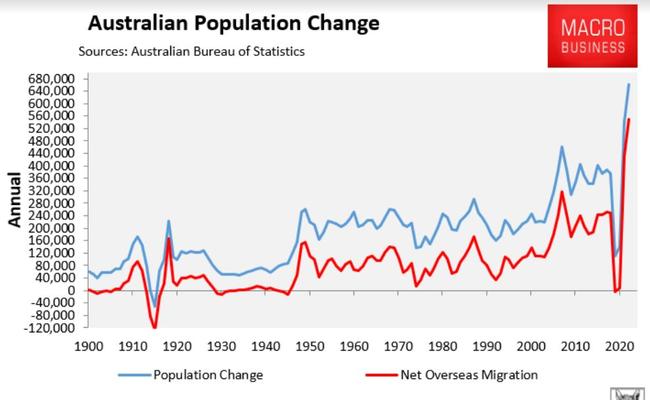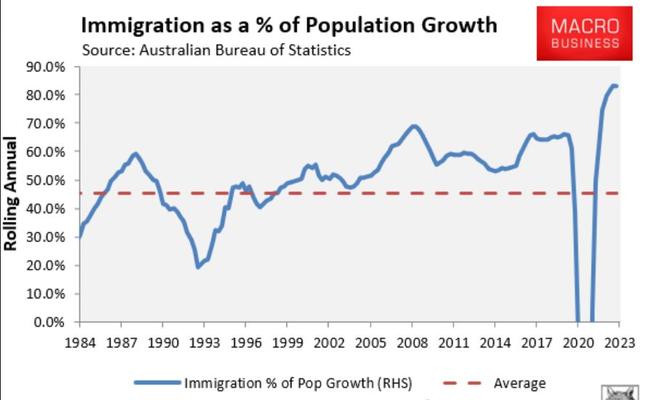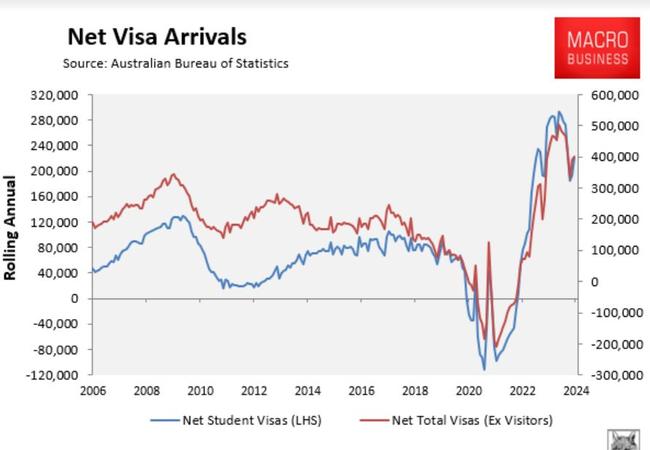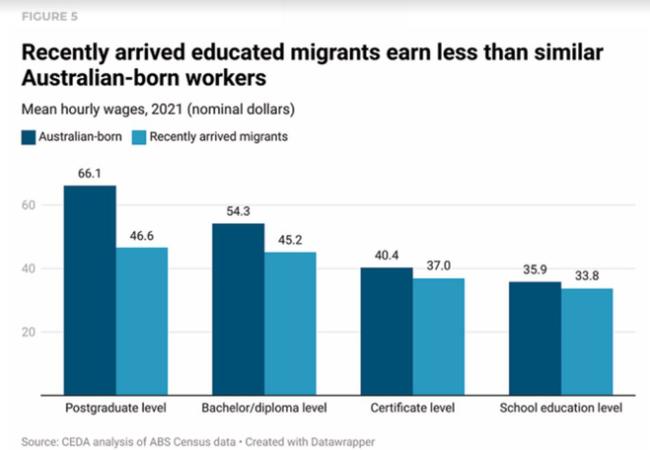‘Simply too high’: Australia nearing crucial immigration ‘peak
Aussies have been warned that a current crisis plaguing the country could become “permanent”.
National
Don't miss out on the headlines from National. Followed categories will be added to My News.
ANALYSIS
Last week, the Australian Bureau of Statistics (ABS) released the official population statistics for the September quarter of 2023, which revealed that Australia’s population grew by an unprecedented 660,000 people over the year, driven by record net overseas migration (NOM) of 549,000.
In percentage terms, Australia’s population grew by 2.5 per cent, the nation’s fastest growth rate since 1952, during the post-war migration boom.
Meanwhile, Australia’s natural population increase was a historically low 111,000 in the year to September 2023, courtesy of a jump in deaths, most likely related to the Baby Boomers beginning to die off and the impacts of the pandemic.
As a result, NOM as a share of Australia’s population increase remained at a record high of 83 per cent in the September quarter of 2023.


Separate annual data released by the ABS for the 2022-23 financial year showed that Australia’s capital cities grew by an unprecedented 517,000 in the year to 30 June 2023.
Melbourne (167,500) led the nation’s population growth last year, followed by Sydney (146,700).
The ABS’ monthly permanent and long-term arrivals data provide a useful proxy for the official quarterly NOM.
Annual net permanent and long-term arrivals hit a record high in January, suggesting that Australia’s official NOM and population growth would have increased further in the December quarter of 2023.
In its December Mid-Year Economic and Fiscal Update (MYEFO), the Albanese government forecast that Australia’s NOM would fall to 375,000 this financial year, which would represent the second-highest annual NOM in Australia’s history.
However, given the acceleration of NOM in the September quarter and the stronger-than-anticipated net permanent and long-term arrivals numbers to January, Australia should expect significantly higher NOM this financial year than the government’s forecast.
The good news is that visa data suggests that NOM is at or near its peak.
According to the ABS, there were 402,000 net visa arrivals (excluding visitors) in the year to February 2024, down from a recent peak of 503,000.
This decline in visa arrivals has been driven by foreign students, which fell to 221,000 in the year to February, down from a recent peak of 294,000.

Australian renters are being smashed
The migration surge’s impact on the nation’s rental market has been particularly severe since the population boom occurred alongside the collapse in dwelling construction to decade-lows.
According to the ABS, Australia added only 155,600 homes (net of demolitions) to the nation’s dwelling stock in the year to September 2023, against a population increase of 660,000.
Therefore, Australia added only one new home for every 4.24 new residents. This explains why the nation’s rental vacancy rate has collapsed to a record low of around one per cent.
Reflecting this demand-supply imbalance, median asking rents across Australia have soared by 38 per cent since the beginning of the pandemic, according to PropTrack, with almost all of this growth occurring after the federal government opened the international border to migration in late 2021.
With Australia’s net overseas migration and population growth to remain historically high for the foreseeable future, and the rate of dwelling construction expected to continue falling, the housing situation will remain fraught.
As a result, Australian tenants should prepare for further tightening of the rental market and ongoing strong rental inflation.

Australia needs a smaller and better-targeted immigration system
Few people would disagree that Australia’s immigration numbers are too high.
While migrants undoubtedly fill important labour market gaps across the economy, the sheer volume of arrivals has placed chronic pressure on the housing market and the nation’s infrastructure.
A report released this month by the Committee for Economic Development of Australia (CEDA) showed that “recent migrants earn significantly less than Australian-born workers” and that “migrants have become increasingly likely to work in lower productivity firms”, earning more than 10 per cent less than Australian-born workers on average.
The CEDA report also showed that the unemployment rates of recent skilled migrants are higher than Australian-born workers.
CEDA’s findings are supported by the latest Graduate Outcomes Survey, which shows that international graduate employment rates, participation rates, and median salaries are well below those of domestic graduates.
Research released in November 2023 by independent economist Gerard Minack showed that Australia’s 8.2 million population increase this century has outpaced the provision of business investment, infrastructure and housing, resulting in what economists call “capital shallowing” and reduced productivity growth.

“Australia’s economic performance in the decade before the pandemic was, on many measures, the worst in 60 years”, Minack wrote in his November report.
“Per capita GDP growth was low, productivity growth tepid, real wages were stagnant, and housing increasingly unaffordable. There were many reasons for the mess, but the most important was a giant capital-to-labour switch: Australia relied on increasing labour supply, rather than increasing investment, to drive growth.
“Australia’s population-led growth model was a demonstrable failure in the 15 years prior to the pandemic. Remarkably, the country now seems to be doubling down on the same strategy. The result, unsurprisingly, is likely to be more of the same.”
To add further insult to injury, data compiled by the Grattan Institute shows that a significantly smaller share of migrants work in the construction sector than their Australian-born counterparts.
“About 32 per cent of Australian workers were foreign born, but only about 24 per cent of workers in building and construction were born overseas”, the Grattan Institute wrote in January.
“And very few recent migrants work in construction. Migrants who arrived in Australia less than five years ago account for just 2.8 per cent of the construction workforce, but account for 4.4 per cent of all workers in Australia”.
Therefore, Australia’s immigration system is directly adding to Australia’s housing and productivity problems in two ways.
First, immigration volumes are simply too high, overwhelming the supply side of the economy.
Second, the migration system is poorly targeted and does not provide the skills the economy needs.
The fact that the nation’s population has ballooned by 8.2 million people (44 per cent) this century alone, yet Australia’s skills shortages are worse than ever, is empirical evidence of these facts.
Australia, therefore, needs a migration system that is much smaller in size and better targeted towards the skills we need.
Australia’s migration system must be calibrated to a level below the nation’s ability to supply homes, infrastructure, and business investment while safeguarding the natural environment (including water supplies).
Otherwise, Australia’s housing shortage will become permanent, and productivity growth and living standards will flounder.
Leith van Onselen is co-founder of MacroBusiness.com.au and Chief Economist at the MB Fund and MB Super. Leith has previously worked at the Australian Treasury, Victorian Treasury and Goldman Sachs.
Originally published as ‘Simply too high’: Australia nearing crucial immigration ‘peak




